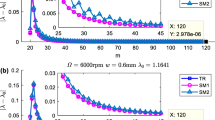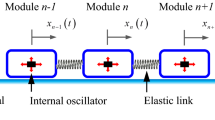Abstract
In this paper, a decoupled and adaptive polishing system without force sensors is designed for the industrial robot to track the rapid change of the contact force and eliminate dynamical nonlinearities in the polishing process. An identification method is proposed to obtain the dynamic model of this system. The system dynamic model is composed of the nominal linear model and the nonlinear model. The parameters of the system linear time-invariant (LTI) model is identified by frequency domain response with the disturbance observer in this paper. Regarding the high order differential terms and uncertain errors of the nonlinear part of the dynamic model, the Long-Short Term Memory (LSTM) is introduced for identifying system nonlinear characteristics. The bounds of the learning rate are discussed and the LSTM stability analysis result shows that the proposed method holds the Lyapunov stability. Finally, the experimental results show that a more accurate dynamic model can be established by combing frequency domain response and LSTM.
Similar content being viewed by others
References
J. Duan, Y. Gan, M. Chen, and X. Dai, “Adaptive variable impedance control for dynamic contact force tracking in uncertain environment,” Robotics and Autonomous Systems, vol. 102, pp. 54–65, April 2018.
J. Li, Y. Guan, H. Chen, B. Wang, T. Zhang, X. Liu, J. Hong, D. Wang, and H. Zhang, “A high-bandwidth end-effector with active force control for robotic polishing,” IEEE Access, vol. 8, pp. 169122–169135, September 2020.
M. Schumacher, J. Wojtusch, P. Beckerle, and O. Stryk, “An introductory review of active compliant control,” Robotics and Autonomous Systems, vol. 119, pp. 185–200, September 2019.
G. V. Troshina and A. A. Voevoda, “The iterative procedure modeling for the dynamic parameters estimation at the active identification task,” Proc. of Siberian Symposium on Data Science and Engineering, pp. 80–83, April 2017.
B. Achili, B. Daachi, A. Ali-Cherif, and Y. Amirat, “A C5 parallel robot identification and control,” International Journal of Control, Automation, and Systems, vol. 8, no. 2, pp. 369–377, April 2010.
Z. Chu, S. Yan, J. Hu, and S. Lu, “Impedance identification using tactile sensing and its adaptation for an underactuated gripper manipulation,” International Journal of Control, Automation, and Systems, vol. 16, no. 2, pp. 875–886, April 2018.
A. A. Adeniran and S. El Ferik, “Modeling and identification of nonlinear aystems: A review of the multimodel approach — Part 1,” IEEE Trans. on Systems, Man, and Cybernetics: Systems, vol. 47, no. 7, pp. 1149–1159, 2017.
S. Lu, J. Zhou, B. Yan, and F. Zhou, “Adaptive speed control of linear servo system with friction compensation,” Proc. of the 27th Chinese Control and Decision Conference (2015 CCDC), pp. 3204–3207, July 2015.
D. Lee and J. Ahn, “Dual speed control scheme of servo drive system for a nonlinear friction compensation,” IEEE Transactions on Power Electronics, vol. 23, no. 2, pp. 959–965, March 2008.
S. Wang and J. Na, “Parameter estimation and adaptive control for servo mechanisms with friction compensation,” IEEE Trans. on Industrial Informatics, vol. 16, no. 11, pp. 6816–6825, 2020.
H. Chen and N. Sun, “An output feedback approach for eegulation of 5-DOF offshore cranes with ship yaw and roll perturbations,” IEEE Transactions on Industrial Electronics, vol. 69, no. 2, pp. 1705–1716, February 2022.
M. Souza, L. de M. Honório, and E. de Oliveira, “Innovative analysis for parameter estimation quality,” International Journal of Control, Automation, and Systems, vol. 19, pp. 363–371, September 2021.
C. Mao, Z. Chen, S. Li, and X. Zhang, “Separable nonlinear least squares algorithm for robust kinematic calibration of serial robots,” Journal of Intelligent & Robotic Systems, vol. 101, no. 1, pp. 2, December 2020.
A. Mohammadi, M. Tavakoli, H. Marquez, and F. Hashemzadeh, “Nonlinear disturbance observer design for robotic manipulators,” Control Engineering Practice, vol. 21, no. 3, pp. 253–267, March 2013.
W. Chen, D. Ballance, P. Gawthrop, and J. O’Reilly, “A nonlinear disturbance observer for robotic manipulators,” IEEE Transactions on Industrial Electronics, vol. 47, no. 4, pp. 932–938, August 2000.
H. **, X. Zhao, and T. Wang, “Modified complementary sliding mode control with disturbance compensation for permanent magnet linear synchronous motor servo system,” IET Electric Power Applications, vol. 14, no. 11, pp. 2128–2135, July 2020.
B. Sahu, M. Mohanty, S. Padhi, and P. Nayak, “Performance analysis of novel adaptive model for nonlinear dynamics system identification,” Proc. of International Conference on Communications and Signal Processing, pp. 945–949, April 2015.
W. Yu, H. Liang, X. Dong, and Y. Luo, “Modeling and identification of permanent magnet synchronous motor via deterministic learning,” IEEE Access, vol. 8, pp. 168516–168525, September 2020.
Y. Zhang, D. Kim, Y. Zhao, and J. Lee, “PD control of a manipulator with gravity and inertia compensation using an rbf neural network,” International Journal of Control, Automation, and Systems, vol. 18, no. 12, pp. 3083–3092, October 2020.
Y. Pan and H. Yu, “Biomimetic hybrid feedback feedforward neural-network learning control,” IEEE Transactions on Neural Networks and Learning Systems, vol. 28, no. 6, pp. 1481–1487, June 2017.
B. Zhao and Y. Li, “Model-free adaptive dynamic programming based near-optimal decentralized tracking control of reconfigurable manipulators,” International Journal of Control, Automation, and Systems, vol. 16, no. 2, pp. 478–490, January 2018.
P. Agand, M. Shoorehdeli, and A. Khaki-Sedigh, “Adaptive recurrent neural network with Lyapunov stability learning rules for robot dynamic terms identification,” Engineering Applications of Artificial Intelligence, vol. 65, pp. 1–11, October 2017.
Z. Man, H. Wu, S. Liu, and X. Yu, “A new adaptive back-propagation algorithm based on Lyapunov stability theory for neural networks,” IEEE Transactions on Neural Networks, vol. 17, no. 6, pp. 1580–1591, November 2006.
A. Banakar, J. Ruckmann, and L. Simoni, “Lyapunov stability analysis of gradient descent-learning algorithm in network training,” ISRN Applied Mathematics, vol. 2011, pp. 1–12, July 2011.
R. Kumar, S. Srivastava, J. Gupta, and A. Mohindru, “Diagonal recurrent neural network based identification of nonlinear dynamical systems with Lyapunov stability based adaptive learning rates,” Neurocomputing, vol. 287, pp. 102–117, February 2018.
N. Acir and E. Mengüç, “Lyapunov theory based adaptive learning algorithm for multilayer neural networks,” Neural Network World, vol. 24, no. 6, pp. 619–636, 2014.
Y. Wang, “A new concept using LSTM neural networks for dynamic system identification,” Proc. of American Control Conference (ACC), pp. 5324–5329, May 2017.
J. Gonzalez and W. Yu, “Non-linear system modeling using LSTM neural networks,” IFAC-PapersOnLine, vol. 51, no. 13, pp. 485–489, June 2018.
H. Farazi and S. Behnke, “Online visual robot tracking and identification using deep LSTM networks,” Proc. of IEEE/RSJ International Conference on Intelligent Robots and Systems, pp. 6118–6125, October 2017.
H. Kang, S. Yang, J. Huang, and J. Oh, “Time series prediction of wastewater flow rate by bidirectional LSTM deep learning,” International Journal of Control, Automation, and Systems, vol. 18, no. 12, pp. 3023–3030, 2020.
H. Chen and N. Sun, “Nonlinear control of underactuated systems subject to both actuated and unactuated state constraints with experimental verification,” IEEE Trans. on Industrial Electronics, vol. 67, no. 9, pp. 7702–7714, 2020.
Author information
Authors and Affiliations
Corresponding author
Additional information
This work was supported in part by the National Natural Science Foundation of China (61973099).
Hao An received his Bachelor’s degree from Taiyuan University of Technology, China, in 2016, and an M.S. degree in Control and Simulation Center from Harbin Institute of Technology, China, in 2018. He is currently pusuing a Ph.D. degree with the Research Institute of Intelligence Control and Systems, Harbin Institute of Technology. His research interests include robotic dynamics, system identification, and reinforcement learning.
Sining Zhang received his Bachelor’s degree from Nan**g Normal University, Nan**g, China, in 2020. He is currently pursuing an M.Eng. degree with the Research Institute of Intelligence Control and Systems, Harbin Institute of Technology. His research interests include robot systems, compliance control, and reinforcement learning.
Chaoran Cui received his Bachelor’s degree in automation from Harbin Engineering University, China, in 2019, and an M.S. degree in control science and engineering from Harbin Institute of Technology, China, in 2021. His research interests include robotic kinematics, dynamics, and trajectory planning.
Cheng Qian received his Bachelor’s degree in mechatronics engineering from the Harbin Institute of Technology, Harbin, China, in 2014, and an M.Sc. degree in mechanical engineering from the University of Sheffield, Sheffield, UK, in 2016. He is currently pursuing a Ph.D. degree with the Research Institute of Intelligence Control and Systems, Harbin Institute of Technology. His research interests include microdevices, micro manipulation, image processing, and visual servo system.
Weiyang Lin received his Bachelor’s and M.S. degrees in mechanical engineering from Harbin Institute of Technology, China, in 2006 and 2008, respectively; and a Ph.D. degree in mechatronics engineering from Harbin Institute of Technology Shenzhen Graduate School, China, in 2014. Currently, he is an Associate Professor in the Research Institute of Intelligent Control and Systems, Harbin Institute of Technology. His research interests include parallel manipulators, robotic motion control, and medical robotic design and control.
Publisher’s Note
Springer Nature remains neutral with regard to jurisdictional claims in published maps and institutional affiliations.
Rights and permissions
About this article
Cite this article
An, H., Zhang, S., Cui, C. et al. Dynamic Model Identification for Adaptive Polishing System. Int. J. Control Autom. Syst. 20, 3110–3120 (2022). https://doi.org/10.1007/s12555-021-0205-y
Received:
Revised:
Accepted:
Published:
Issue Date:
DOI: https://doi.org/10.1007/s12555-021-0205-y




